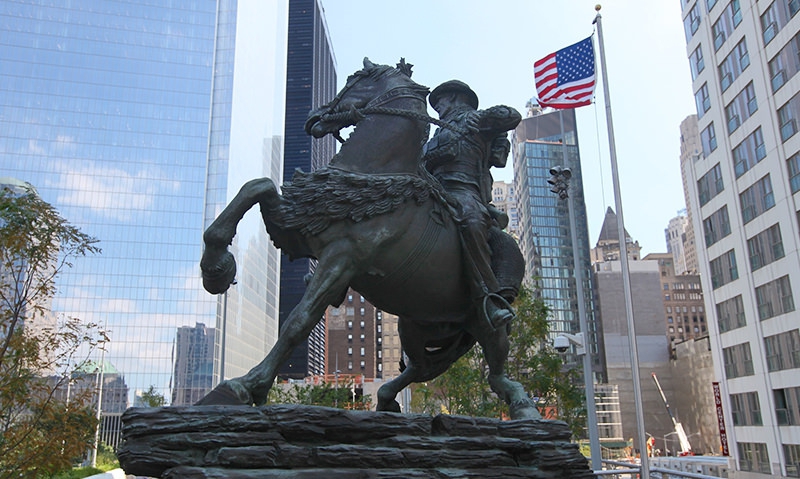
Hollywood spotlights ‘Horse Soldier’ statue
To art lovers, history buffs and Americans simply wishing to pay homage to America’s Special Operations community, Manhattan’s America’s Response monument may be the Big Apple’s best-kept cultural secret. Awareness may be changing soon with the nationwide release of Jerry Bruckheimer’s “12 Strong: The Declassified True Story of the Horse Soldiers.”
Starring Chris Hemsworth, the film prominently features the New York City monument sculpted by renowned artist Douwe Blumberg, who was featured in the and whose Nevada State Veterans Memorial-Las Vegas was commended by an American Legion National Executive Committee resolution in May 2015.
The 18-foot bronze sculpture overlooking the site of the World Trade Center attack on Sept. 11, 2001, tells the little-known story of the first Americans to ride horses into combat in more than 50 years during the winter of 2001-2002 in Afghanistan.
As if mirroring the clandestine nature of the missions it honors, the “Horse Soldier Monument,” as it is known, quietly stands sentinel over Ground Zero. Dedicated in 2016 at Liberty Park across the street from the World Trade Center site and the 9/11 museum, one almost has to be looking for it to find it. But once found, its artistry, scale and presence are unforgettable.
Blumberg’s original table-sized bronze limited-edition (still available from the artist at www.douwestudios.com) was inspired by a grainy 2002 DoD photo of U.S. Army Special Forces personnel (Green Berets) mounted on rugged Afghan horses. The visual irony of a 21st century, high-tech soldier on an Afghan mountain horse, visually unchanged for centuries, captivated Blumberg. Having been a professional horse trainer prior to his art career and a passionate supporter of U.S. military service, capturing the image in bronze was his way of responding to 9/11, he explained. Close collaboration with actual “horse soldiers” who were in Afghanistan immediately upon their return from these missions ensured historical accuracy of the monument.
Literally within days of 9/11, U.S. Army Special Operations units were actively engaged in Afghanistan, trailing the Taliban on horseback. The Special Forces team he worked with had arrived in Afghanistan with no riding experience among them, save one. They spent the next 30 days in the saddle, assisting their Northern Alliance allies in attacking Taliban forces through some of the most daunting, isolated mountain terrain in the world.
Success encouraged many smaller rebel groups to join the campaign until it ended with the capture of the northern city of Mazar-e Sharif. By then, the group had a force of almost 2,000 mounted soldiers. According to their captain, “It looked like something out of Lawrence of Arabia.” These were the first U.S. soldiers to ride horses into combat in more than 50 years. This particular mission is only a sampling of the diverse and challenging missions performed by the unconventional American warriors throughout the operation.
One of Blumberg’s goals, he said, was to make the monument “artistically relevant” to a wide demographic and to resonate powerfully with the military community. He intentionally chose to break from the common abstract memorial treatment to create a fusion of styles which he lightheartedly terms “surrealism” to convey the history while preserving the artistry of the sculpture.
“Clearly, no one image can represent the scope of our Special Operations community or their contributions,” he said. “I was drawn to this specific image because it perfectly represents the unique abilities, adaptability, professionalism, missions, courage and fortitude of the American Special Operations warrior. I felt the image of a mounted modern soldier was both startlingly unique and also served to weave a thread through our history, connecting these events with our past. This image also suggested to me two diverse cultures, modern and ancient, working together to fight tyranny and oppression, which I feel is a powerful lesson.
“My vision was to create a world-class monument that will provide a powerful and lasting experience for the viewer. It is my hope that this piece will increase awareness of the contributions made on our behalf by our Special Operations professionals while evoking a deep sense of gratitude, respect and appreciation for those heroes who have so effectively, faithfully and quietly preserved our freedoms. With this piece, New York leads the way in making up for an embarrassing lack of monuments to honor America’s Special Operations warriors.”
Having a World War II veteran father and a mother who lost her father to the Nazis in Europe, the military genre engages Blumberg’s passion. “I understand this is a nation founded upon the blood, sweat and tears of our veterans and their loved ones. I am extremely honored and humbled to be able to use my artistic gift to help bring permanent honor and recognition to these heroes who have sacrificed so much to protect the freedoms we enjoy and often take for granted.”
He added that he hopes a Hollywood blockbuster like “12 Strong” will honor the sacrifices, abilities and accomplishments of America’s special operators and also give the Horse Soldier statue a prominent place on New York’s map of preeminent attractions.
